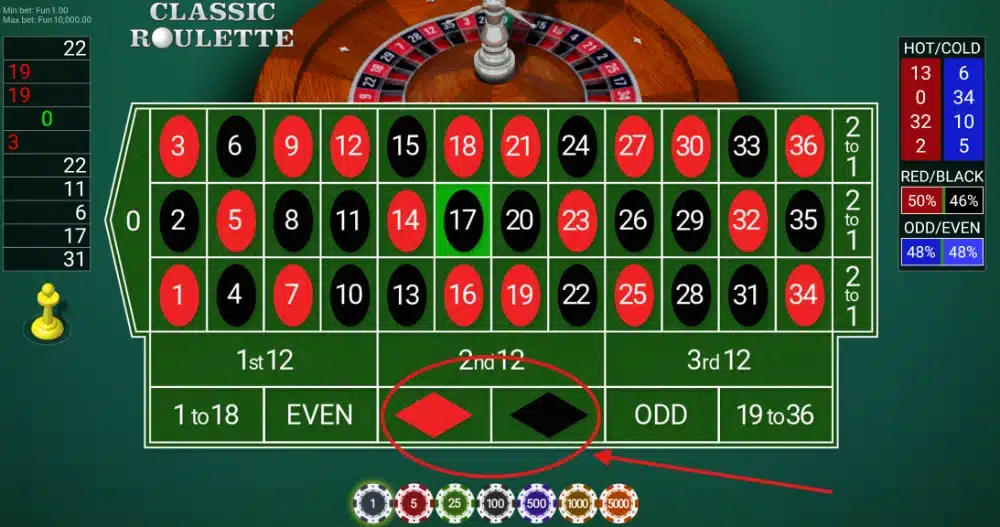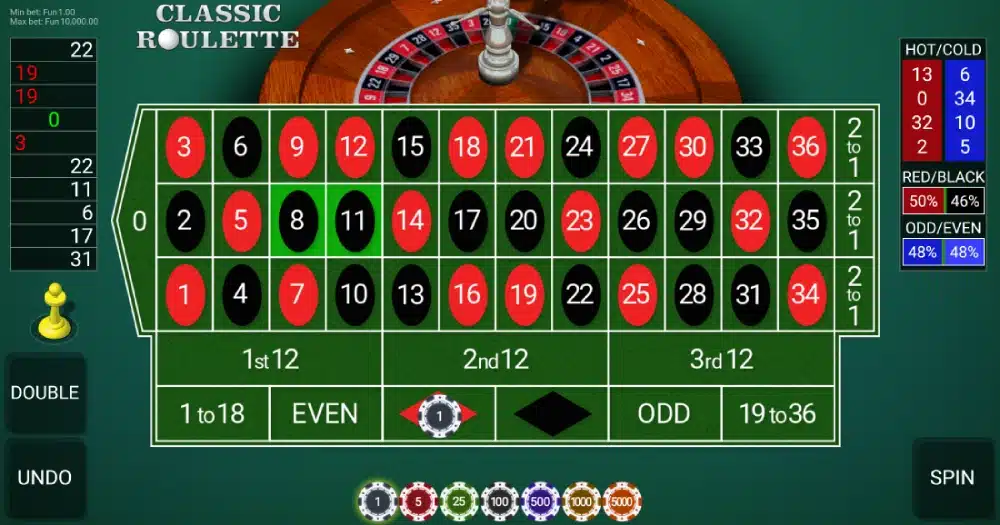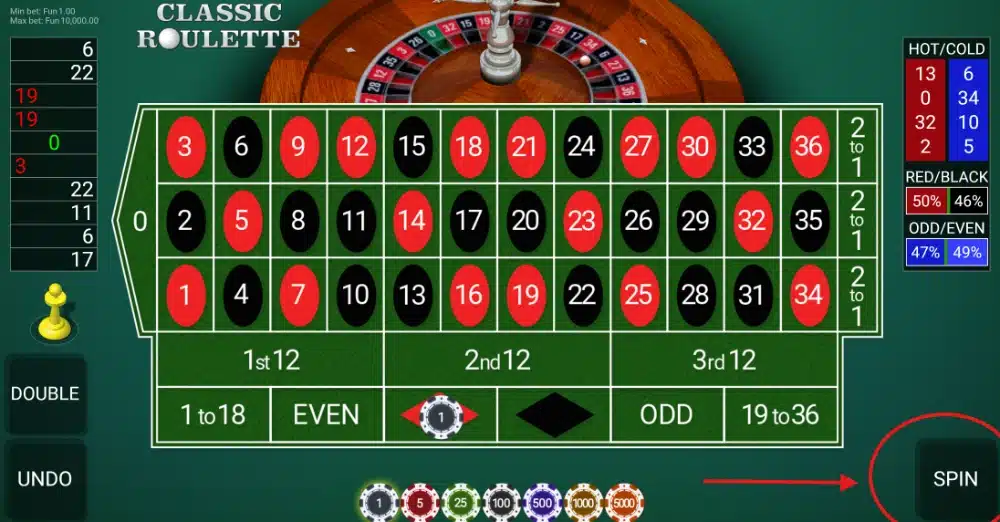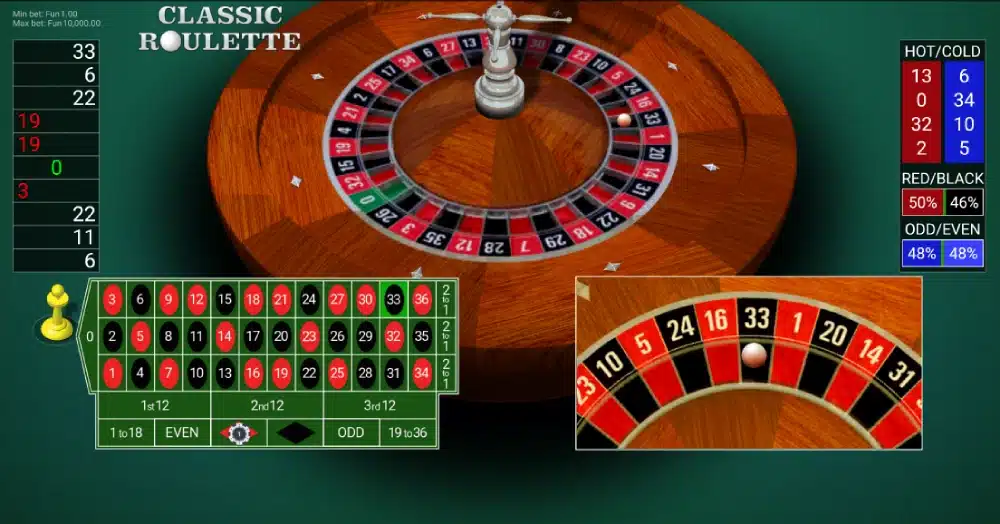Self-Hyena method and its strong impact on casino strategy The Self-Hyena method has become a growing topic of discussion in casino strategy circles. Often described as a hybrid approach to betting, it attracts attention as it relies less on pure chance. You are relying more on keen observation, timing, and discipline with the Self-Hyena method, […]
Understanding D'Alembert method disadvantages for smarter gameplay
The D'Alembert system is one of the most popular betting methods for roulette players who prefer a structured, cautious approach. Its appeal lies in its gradual bet increases, which feel safer than aggressive systems like the Martingale system. However, slow doesn’t always mean safe. Losing streaks, table limits, and modest payouts can still put your bankroll at risk if you’re unprepared. This guide explores the key D'Alembert method disadvantages and gives you practical tips to use it wisely for more controlled and confident gameplay at Bitcasino.
What is the D'Alembert method?
The D'Alembert method is a type of progressive betting system where you change your bet based on the result of the last round. When you lose, add one unit to your next bet; if you win, decrease by one unit. It’s most commonly used in casino games like roulette on ‘even-money’ bets (Red/Black, Odd/Even).
Here is a simple, step-by-step example:
- Establish a base unit: Decide on a small, consistent betting unit. For this example, let's say your unit is 1 USDT.
- Place your first bet: You bet 1 USDT on a colour in roulette (e.g., Red).
- After a loss: If you lose, you increase your next bet by one unit. Your next bet would be 2 USDT.
- After a win: If you win, you decrease your next bet by one unit. Your next bet would be back down to 1 USDT.
The logic behind the system is that over a large number of hands, the number of wins and losses should eventually even out. By decreasing your bets after a win and increasing them after a loss, you theoretically profit, as your winning bets would be made at a higher average wager than your losing ones.
How to use the D'Alembert method in even-chance casino games
For a better explanation, below is a short step-by-step process of how you can use this method:
Step 1: Choose your betting type

For this method, you need to choose whether you’re going to bet on red or black or even or odd.
Step 2: Place your bet

Once you’ve chosen, click on it to place your bet. For this example, we bet 1 USDT on red.
Step 3: Hit the spin button

After placing your bet, press the ‘Spin’ button to start the round. You either win or lose. Remember, if you lose, you add one unit to your bet, and if you win, you deduct one.
Step 4: Keep following the betting system until you want to stop

In this example, we lost our bet, so we added another 1 USDT to our bet (2 USDT) and did another roll, following the D'Alembert betting method.
In this case, we won the round and gained a profit of 1 USDT.
- Total wagered: You bet 1 USDT (Round 1) + 2 USDT (Round 2) = 3 USDT.
- Total winnings: You received a total of 4 USDT from your winning bet in Round 2.
- Net profit: Your total winnings (4 USDT) minus your total wagers (3 USDT) results in a net profit of 1 USDT.
In this example, the D'Alembert method allowed you to recover the loss from your first bet and still gain a profit equal to your initial betting unit (1 USDT) with just one winning spin.
D'Alembert method simulation
To see how the D'Alembert system plays out, below is a simple run with a starting bet of 5 USDT. Each loss raises the next bet by 1 USDT, and each win lowers it by 1 USDT. The short-term looks steady, but notice how losses build up when a bad streak hits.
| Number of Times | Bet amount | Win or Lose | Profit and loss amount | Accumulated income and expenditure |
| 1 | 5 USDT | ◯ | 5 USDT | 5 USDT |
| 2 | 4 USDT | ✕ | -4 USDT | 1 USDT |
| 3 | 5 USDT | ✕ | -5 USDT | -4 USDT |
| 4 | 6 USDT | ✕ | -6 USDT | -10 USDT |
| 5 | 7 USDT | ✕ | -7 USDT | -17 USDT |
| 6 | 8 USDT | ◯ | +8 USDT | -9 USDT |
| 7 | 7 USDT | ◯ | +7 USDT | -2 USDT |
| 8 | 6 USDT | ✕ | -6 USDT | -8 USDT |
| 9 | 7 USDT | ✕ | -7 USDT | -15 USDT |
| 10 | 8 USDT | ✕ | -8 USDT | -23 USDT |
| 11 | 9 USDT | ✕ | -9 USDT | -32 USDT |
| 12 | 10 USDT | ◯ | +10 USDT | -22 USDT |
| 13 | 9 USDT | ◯ | +9 USDT | -13 USDT |
| 14 | 8 USDT | ◯ | +8 USDT | -5 USDT |
| 15 | 7 USDT | ◯ | +7 USDT | +2 USDT |
This simulation created a random set of 15 wagers that show a balanced win-loss ratio. As seen above, the simulation shows 15 bets that led to a 2 USDT profit. This means there is a chance of profit, but it is still a risk because there is no guarantee whether you’ll get it sooner or later.
Mistakes that make the D'Alembert method unwinnable
The D'Alembert system can add structure to betting, but it cannot change the mathematical house edge built into every casino game. Many players make costly errors that turn this method into a guaranteed loss over time.
Common mistakes include skipping stop-loss limits, choosing games with a higher-than-average house edge, increasing bet sizes too aggressively, and assuming that losing streaks will end soon. Recognising these risks is essential for anyone who wants to use the D'Alembert method responsibly and avoid draining their bankroll.
Deep dive into these mistakes below:
1. Not setting a stop-loss limit
Without a clear stop point, players often chase losses for too long. This can drain your bankroll in one session and leave no chance of recovery. A stop-loss rule helps control the risks of overspending, but many skip it because it seems like a hassle to them or they want to go straight to gaming—neither of which you should do.
2. Playing games with a high house edge
The D'Alembert works best in even-chance bets with low house edge, such as red/black in roulette, since this system relies on a near 50/50 outcome. Using it on games or side bets with a higher edge only speeds up losses because the odds are further from even. With each bet more likely to lose than win, the system has less opportunity to balance out wins and losses, causing the player’s bankroll to decline faster.
3. Betting too aggressively
The D’Alembert betting style is more of a gradual increase (one unit after each loss) rather than aggressive. This makes a slower, more controlled strategy. However, some players start with larger units or increase stakes too quickly, hoping for faster wins, which removes the ‘slow and steady’ nature of this betting method. This puts the player’s bankroll under pressure because it will keep deducting money upon losing.
4. Assuming losing streaks will end quickly
Many players fall into the trap of believing that after many losses, a win must be coming soon—a classic case of the gambler’s fallacy. In reality, each spin or hand is independent, meaning losing runs can last longer than expected and tempt players to raise bets beyond their bankroll.What are the drawbacks of the D'Alembert method?

This betting system has some clear drawbacks that every player should know. Long losing runs can drain your bankroll faster than expected, table limits can stop your bets from growing further, and the house edge is always present, cutting into any plan.
Learn more about these drawbacks below:
Drawback 1: Long losing streaks
The D'Alembert system may look safe because you only raise your bet by one unit after each loss. However, if you hit a long run of losses, those small increases add up quickly, and your bet size can still grow quite high. This can eat through your bankroll before you get a chance to win it back, and just like that, you’re back to depositing money into your wallet again.
Drawback 2: Table limits
Casinos set table limits to control betting. In a long losing streak, your stakes may reach this maximum, stopping you from raising bets as the D’Alembert system requires. When this happens, it becomes impossible to recover losses through progression, which is a key risk of this method.
Drawback 3: The house edge
No matter which betting system you use, the casino’s house edge stays the same. The D'Alembert method simply structures your bets, but does not change the game’s odds. This means that over time, the house advantage will gradually reduce your bankroll.
Drawback 4: Low profit potential
Because the D'Alembert system adjusts bets by only one unit, profits grow slowly. Even on a winning streak, the method limits how quickly your returns increase, making it less appealing to players who prefer aggressive strategies or faster gains.
Drawback 5: Time and patience needed
Recovering from a losing streak with the D'Alembert system can take many rounds, leading to long sessions. This slow pace can test a player’s patience, and fatigue may cause mistakes or deviation from the strategy, reducing its effectiveness.
The secret to winning with the D'Alembert system and avoiding endless losses
The drawbacks of the D'Alembert system might make the method unappealing, but that doesn’t mean you can’t counter it with smart betting. With the right approach, players can reduce the risks and use the system more safely. By setting clear limits and treating it as a tool for control rather than guaranteed profit, the D'Alembert can still be part of a balanced betting plan.
Here are some tips to use it more wisely:
- Set a stop-loss limit
Since it was mentioned before that not setting a stop-loss limit is one of the mistakes, it should be one of the ways to avoid an endless losing streak. It is easy to keep raising bets after a few losses, but this is how bankrolls disappear. A stop-loss limit gives you a clear point where you should stop playing, no matter what the game looks like.
- Have a win goal
Winning a few rounds in a row can feel like the system works perfectly, but luck can change at any time. A set win goal helps you take profits when you are ahead instead of giving them back to the casino. This makes your play sessions shorter and less risky, giving you a more promising gameplay.
- Manage your bankroll carefully
Your betting unit should always be a small part of your total bankroll. For example, if you bring 100 USDT, a 1 USDT or 2 USDT unit is much safer than 5 USDT or 10 USDT. This way, even during long losing runs, you will not lose much money quickly.
- Avoid high house edge bets
Some bets in the same game look tempting because they pay more, but often come with worse odds. For example, roulette side bets like single numbers have a much higher edge than simple red/black wagers. Combining the D'Alembert with these risky bets will drain your bankroll faster.
- Use it in games with even-money bets
The D'Alembert system works best with even-money bets, such as red/black in roulette or banker/player in baccarat. Using it on bets with uneven payouts disrupts the progression and makes recovering losses harder, so stick to these even-chance options to keep the system effective.
Improved D'Alembert method: Do variations improve your chances of winning?
The D'Alembert is already viewed as a more cautious method than aggressive systems like the Martingale system. However, there is one popular method that others use in place of the D’Alembert method, the ‘Reverse D’Alembert system.’
It flips the logic of the classic method. Instead of increasing your bet after a loss and decreasing it after a win, the Reverse D’Alembert raises your stake after a win and lowers it after a loss.
Here’s a short step-by-step to better show you how it works:
Step 1: Start with a base bet (e.g 1 USDT) on an even-chance wager like roulette’s red/black.
Step 2: If you win, increase your next bet by 1 unit. Your next bet should be 2 USDT.
Step 3: If you lose, decrease your next bet by 1 unit. This will then turn your next bet into just 1 USDT.
Step 4: Repeat this process, gradually building your bets during winning streaks and reducing them when losing.
This basic step-by-step shows that the concept is just the reversed version of the D’Alembert. Instead of decreasing your bets when you win, you do the opposite and increase your bet by one unit.
The classic D’Alembert is cautious, aiming to recover losses slowly by raising bets after losing, but the Reverse D’Alembert seeks to capitalise on winning streaks by increasing bets. Both systems cannot overcome the house edge, but the Reverse version can feel more dynamic and potentially more rewarding during streaks, while the original prioritises slow, steady play.
Try the D'Alembert betting system on Bitcasino’s casino games today!
Now that you know how to use the D'Alembert betting method, its drawbacks, and how to manage them, you can put your knowledge to the test on even-chance games like roulette and baccarat at Bitcasino. Use ‘Fun Mode’ to practice first and build confidence before playing for real money.
Apply the tips from this guide to stay in control, play strategically, and enjoy a more structured approach to betting. You can even adjust the system to suit your style for smarter, more enjoyable gameplay. Try this betting method today on Bitcasino roulette games and see if it fits your playing style and bankroll.
Frequently asked questions (FAQs)
Can the D'Alembert Method be improved?
Yes, some players adjust it by gradually changing bet sizes. Remember that these tweaks only manage risk; they don’t remove the house edge.
Does the system work long-term?
It can work long-term, but cannot beat the house edge, so losses eventually outweigh wins over time. Even careful play will end in a net loss if a player stays too long.
Why do many players say the D'Alembert method is unwinnable?
Because long losing streaks, table limits, and the fixed house edge make it impossible to guarantee recovery. Many players wrongly assume balance will always return, but real results often don’t match this theory.
Is the D'Alembert system suitable for beginners?
Yes, it’s simpler and less risky than Martingale, making it approachable for new players who want to manage bets slowly. It also helps beginners avoid the sharp swings of more aggressive systems.
What games is the system best suited for?
It works best in even-money chance games like roulette (red/black, odd/even) or baccarat banker/player bets. These options give the closest to 50/50 results, which is where the method is designed to work.
Does the D'Alembert method guarantee smaller losses?
Not always. While it aims to reduce risk by increasing bets slowly, long losing streaks can still drain a bankroll. The method only makes losses feel more gradual, not avoidable.
What is the main advantage of the D'Alembert system?
Its biggest strength is its simplicity and slower bet progression, which makes it easier for players to manage their bankroll. This balanced pace is why many see it as less stressful compared to faster-growing systems.

Actual payout amounts will vary depending on the currency you use.















